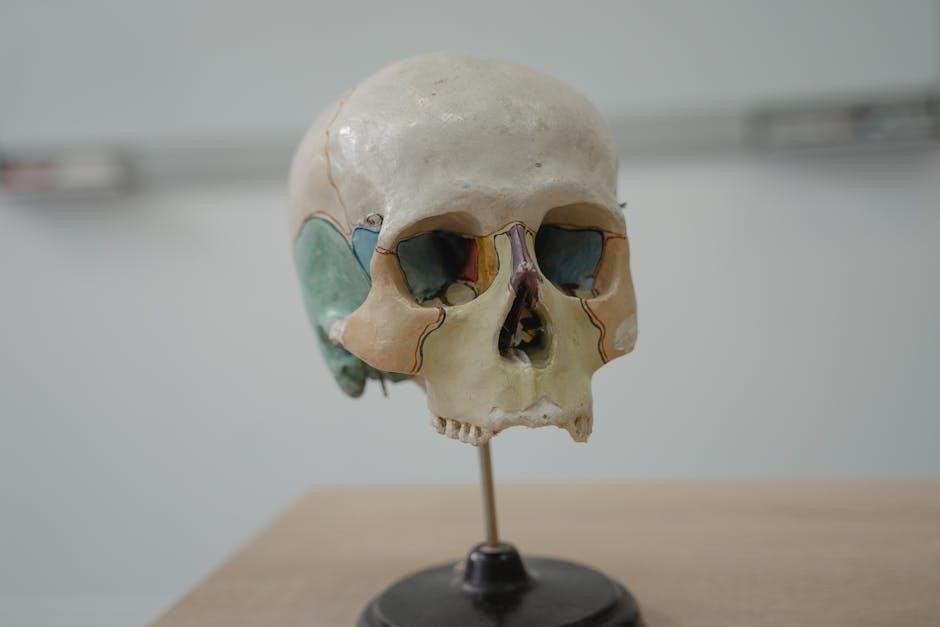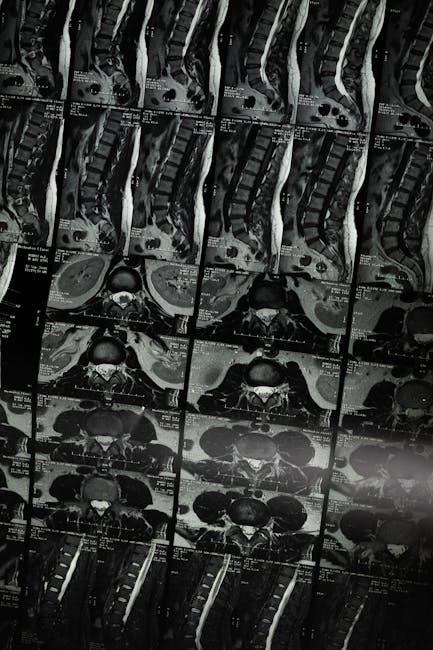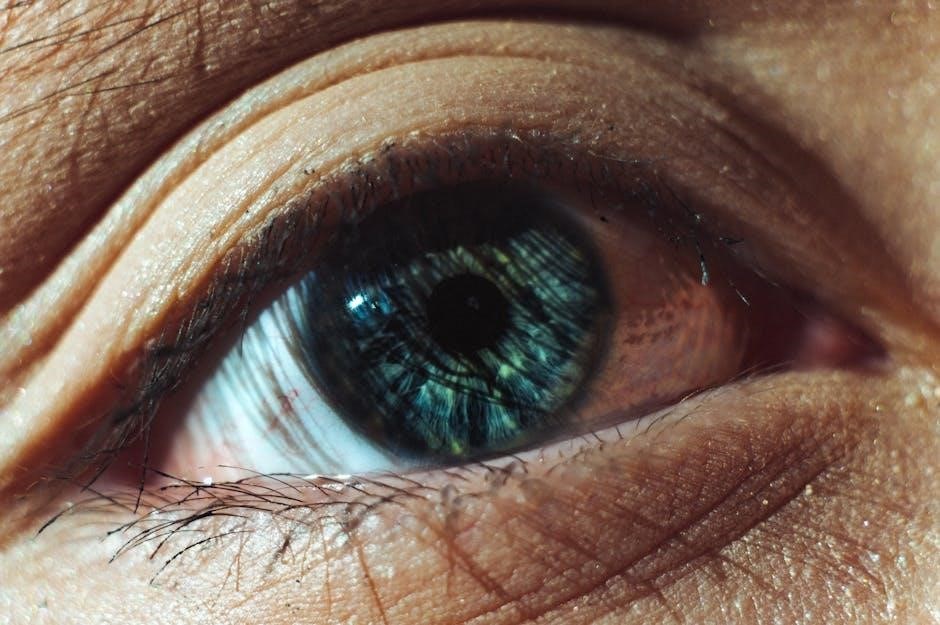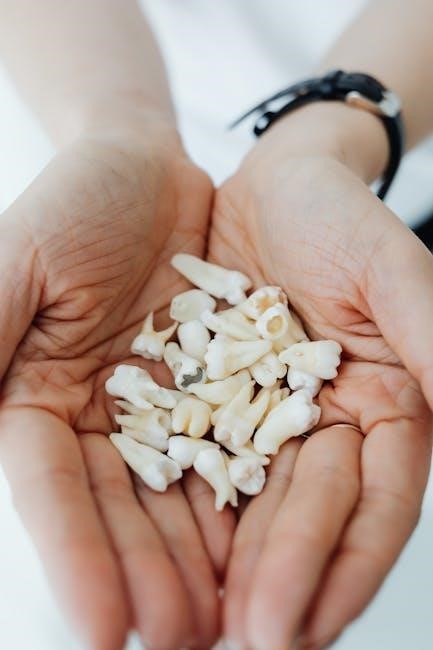Anatomy and physiology explore the structure and function of the human body, providing essential knowledge for healthcare, education, and understanding life processes․ This foundational study combines the physical composition of organs and systems with how they interact to maintain overall health, making it vital for medical professionals and students alike․
1․1 What Is Anatomy and Physiology?
Anatomy and physiology are interconnected sciences focusing on the human body’s structure and functions․ Anatomy examines the physical components, such as organs and tissues, while physiology explores how these parts work together to maintain life․ Together, they provide a comprehensive understanding of how the body operates, essential for healthcare professionals and students․ These disciplines form the basis of medical knowledge, enabling insights into health, disease, and the intricate mechanisms that sustain life․
1․2 Why Study Anatomy and Physiology?
Studying anatomy and physiology is crucial for understanding how the human body functions․ It provides foundational knowledge for careers in healthcare, enabling professionals to diagnose and treat conditions effectively․ Beyond healthcare, it aids in appreciating the complexity of the human organism, promoting better health choices and fitness practices․ This study also fosters scientific literacy, empowering individuals to make informed decisions about their well-being and engage with health-related topics confidently․
1․3 Overview of the Human Body Systems
The human body comprises 12 major systems, each performing distinct yet interconnected roles․ These include the skeletal, muscular, nervous, circulatory, respiratory, digestive, endocrine, urinary, immune, and integumentary systems․ Each system consists of organs and tissues that collaborate to maintain homeostasis and overall health․ Understanding these systems’ structures and functions is essential for appreciating how the body operates as a cohesive unit, enabling better health management and treatment of disorders․

Basic Concepts and Terminology
This section covers fundamental concepts, including Latin and Greek roots, anatomical positions, planes, and key terminology, forming the basis of anatomy and physiology studies․
2․1 Key Terms in Anatomy and Physiology
Mastering key terms is essential for understanding anatomy and physiology․ Terms like “anatomical position,” “dorsal,” and “ventral” describe body orientations․ “Proximal” and “distal” indicate distances from the body’s center․ Understanding these foundational terms helps in comprehending more complex concepts later․ Additionally, terms like “sagittal,” “transverse,” and “coronal” planes are crucial for identifying body sections․ Familiarity with this vocabulary aids in visualizing and communicating anatomical structures effectively, forming the backbone of successful study in this field․
2․2 Understanding Anatomical Positions and Planes
Anatomical positions and planes are fundamental concepts in anatomy and physiology․ The standard anatomical position refers to a standing body with arms at the sides and palms facing forward․ Key terms include “dorsal” (back), “ventral” (front), “proximal” (near the center), and “distal” (far from the center)․ Planes divide the body into sections: sagittal (lengthwise), frontal (vertical), and transverse (horizontal)․ These reference points aid in precise descriptions of body structures, ensuring clarity in medical and educational contexts․ Mastering these concepts enhances understanding of spatial relationships within the human body․
2․3 Latin and Greek Roots in Medical Terminology
Latin and Greek roots form the foundation of medical terminology, enabling precise communication in anatomy and physiology․ Terms like “hemi-” (half) from Greek and “semi-” (half) from Latin illustrate how these languages shape medical vocabulary․ Prefixes and suffixes, such as “-itis” (inflammation) and “-osis” (condition), derive from Greek, while “capit-” (head) and “manus-” (hand) come from Latin․ Understanding these roots simplifies complex terms, aiding students and professionals in decoding medical language effectively․ This linguistic basis enhances clarity and consistency in scientific and healthcare contexts․

The Structure of the Human Body
The human body is organized into cells, tissues, organs, and systems, functioning together to maintain life․ This hierarchical structure ensures efficient operation from microscopic to macroscopic levels․
3․1 Cells and Tissues: The Building Blocks
Cells are the basic structural and functional units of the body, forming the foundation of life․ Tissues are groups of cells with specialized functions, such as epithelial, connective, muscle, and nervous tissues․ These tissues work together to form organs and systems, enabling the body to perform essential functions․ Understanding cells and tissues is crucial for grasping how the body operates, as they are the fundamental components that support growth, repair, and overall health․ Their organization and interaction are vital for maintaining homeostasis and enabling life processes․
3․2 Organs and Organ Systems
Organs are specialized structures composed of two or more types of tissues that perform specific functions․ Organ systems, such as the skeletal, muscular, and nervous systems, are groups of organs working together to maintain overall health․ These systems enable essential processes like movement, digestion, and communication․ Understanding how organs and systems interact is vital for comprehending the body’s complex functions and how they contribute to sustaining life․ This knowledge is fundamental for diagnosing and treating health disorders, emphasizing the interconnectedness of the human body․
3․3 The Importance of Homeostasis
Homeostasis is the body’s ability to maintain a stable internal environment despite external changes․ It regulates factors like temperature, pH, and blood sugar levels, ensuring proper cellular function․ This balance is crucial for overall health, enabling the body to function efficiently and respond to stress․ Without homeostasis, cellular processes would fail, leading to illness or death․ It exemplifies the body’s intricate self-regulatory mechanisms, highlighting the importance of maintaining equilibrium for survival and optimal performance․

Major Body Systems
The human body comprises 12 major systems, including skeletal, muscular, nervous, circulatory, respiratory, digestive, endocrine, urinary, integumentary, immune, and reproductive systems, each vital for maintaining life and function․
4․1 Skeletal System
The skeletal system provides structural support, protects vital organs, and facilitates movement․ Comprising 206 bones, it includes the axial skeleton (skull, spine, ribs) and appendicular skeleton (limbs and girdles)․ Bones are dynamic tissues, undergoing remodeling through osteoblasts and osteoclasts․ Joints connect bones, enabling mobility, while ligaments and tendons offer stability․ This system also produces blood cells in bone marrow and stores minerals like calcium and phosphorus, essential for overall health․ Understanding its functions is crucial for appreciating human anatomy and physiology․
4․2 Muscular System
The muscular system enables movement, maintains posture, and regulates body temperature․ It comprises three types of muscles: skeletal (voluntary, attached to bones), smooth (involuntary, found in internal organs), and cardiac (found only in the heart)․ Muscles function by contracting and relaxing, working in coordination with the skeletal system․ They are essential for locomotion, digestion, and blood circulation․ Understanding muscle anatomy and physiology is vital for grasping how the body performs daily functions and maintains overall health․
4․3 Nervous System
The nervous system is a complex network controlling voluntary and involuntary functions, such as movement, sensation, and organ activity․ It consists of the central nervous system (brain and spinal cord) and the peripheral nervous system (nerves)․ Neurons transmit signals through electrical and chemical impulses, enabling communication within the body․ This system regulates digestion, heart rate, and mental processes, making it essential for maintaining life and enabling interaction with the environment․ Understanding its structure and function is crucial for appreciating overall bodily control and coordination․
4․4 Circulatory System
The circulatory system, also known as the cardiovascular system, is responsible for transporting blood throughout the body; It consists of the heart, arteries, veins, and capillaries․ The heart acts as the central pump, propelling blood through the vessels․ Arteries carry oxygen-rich blood away from the heart, while veins return oxygen-depleted blood to it․ This system is crucial for delivering oxygen and nutrients to cells and removing waste products, maintaining homeostasis․ It also plays a role in immunity and hormone transport, highlighting its vital interconnectedness with other body systems․
4․5 Respiratory System
The respiratory system facilitates the exchange of oxygen and carbon dioxide through the process of breathing․ It includes the nasal cavity, trachea, bronchi, and lungs, with alveoli being the sites of gas exchange․ Inhalation brings oxygen-rich air into the lungs, while exhalation removes carbon dioxide․ This system is essential for delivering oxygen to the bloodstream, which is then distributed to cells for energy production․ It also supports the circulatory system by ensuring proper oxygenation of blood, maintaining overall bodily function and homeostasis․
4․6 Digestive System
The digestive system is responsible for breaking down food into nutrients that the body can absorb and utilize for energy, growth, and repair․ It includes the mouth, esophagus, stomach, small intestine, and large intestine․ Mechanical digestion occurs through chewing and muscle contractions, while enzymes facilitate chemical digestion․ Nutrients are absorbed into the bloodstream primarily in the small intestine, and waste is eliminated through the large intestine․ Proper digestion is crucial for maintaining overall health and ensuring the body receives essential nutrients for optimal functioning and homeostasis․
4․7 Endocrine System
The endocrine system regulates bodily functions through hormones, chemical messengers produced by glands like the pancreas, thyroid, and adrenal glands․ These hormones control metabolism, growth, and reproductive processes․ The pancreas produces insulin and glucagon to manage blood sugar, while the thyroid hormone regulates metabolism․ The endocrine system works closely with the nervous system to maintain homeostasis, ensuring proper cellular and organ function․ Understanding this system is crucial for managing conditions like diabetes and hormonal imbalances, which significantly impact overall health and well-being․
4․8 Urinary System
The urinary system, also known as the renal system, is responsible for removing waste and excess fluids from the body through urine production․ It consists of the kidneys, ureters, bladder, and urethra․ The kidneys filter blood to produce urine, which travels through the ureters to the bladder for storage․ The urethra then excretes urine from the body․ This system regulates electrolyte balance, blood volume, and pH levels, playing a vital role in maintaining homeostasis․ Understanding its functions is essential for diagnosing and managing conditions like kidney stones, infections, and urinary disorders․
4․9 Integumentary System
The integumentary system is the body’s outer layer, comprising the skin, hair, nails, and associated glands․ It protects against external damage, regulates body temperature, and aids in sensory perception․ The skin acts as a barrier, preventing water loss and shielding internal organs from pathogens․ Sweat glands help cool the body, while sebaceous glands maintain skin health․ This system also plays a role in vitamin D production․ Disorders like acne, eczema, and skin cancer highlight its importance in overall health and bodily defense mechanisms․ Understanding its functions is crucial for maintaining skin health and preventing diseases․
4․10 Immune System
The immune system is the body’s defense mechanism, protecting against pathogens, infections, and diseases․ It comprises various organs, tissues, and cells, such as the lymph nodes, spleen, and white blood cells․ The system identifies and neutralizes harmful invaders through innate and adaptive responses․ Innate immunity offers immediate protection, while adaptive immunity provides long-term defense․ Disorders like autoimmune diseases or immunodeficiencies highlight its critical role․ Understanding the immune system’s functions is essential for combating infections and maintaining overall health․ Proper immune function is vital for preventing and recovering from illnesses effectively․

Physiology of the Human Body
Physiology examines how the body functions, focusing on processes like neural control, metabolism, and homeostasis․ It explains how systems interact to maintain health and respond to changes․
5․1 How the Body Systems Interact
The human body operates as an intricate network where systems collaborate to maintain overall health․ For instance, the nervous system communicates with the endocrine system through hormones, regulating processes like metabolism and growth․ The circulatory system transports oxygen and nutrients to cells while removing waste, supporting the metabolic functions of the digestive system․ Similarly, the immune system interacts with the integumentary system, using skin as a barrier to protect against pathogens․ This harmonious interaction ensures the body functions efficiently, adapting to internal and external changes to sustain life․
5․2 Neural and Hormonal Control
Neural and hormonal systems work together to regulate bodily functions․ The nervous system uses electrical and chemical signals to control rapid responses, while the endocrine system employs hormones for slower, long-term adjustments․ For example, the pancreas releases insulin to lower blood sugar, while the nervous system triggers immediate reactions like heart rate changes․ The hypothalamus and pituitary gland act as a bridge, linking neural signals to hormone secretion․ This dual control ensures precise coordination, maintaining homeostasis and enabling the body to adapt to internal and external changes effectively․
5․3 The Role of Feedback Mechanisms
Feedback mechanisms are crucial for maintaining homeostasis, ensuring the body adapts to internal and external changes․ Negative feedback reduces deviations, restoring balance, while positive feedback amplifies responses, like blood clotting․ For example, when blood sugar rises, insulin lowers it, and glucagon raises it if it drops too low․ These mechanisms regulate temperature, blood pH, and hormone levels, preventing extreme fluctuations․ They enable the body to function efficiently, maintaining stability and overall health through precise, automatic adjustments․
Learning Resources for Anatomy and Physiology
Discover essential resources like “Anatomy and Physiology For Dummies” textbooks, workbooks, and online tools․ These guides offer interactive models, practice quizzes, and visual aids to enhance learning and understanding․
6․1 Recommended Textbooks and Guides
For comprehensive learning, “Anatomy and Physiology For Dummies” by Erin Odya and Donna Rae Siegfried is highly recommended․ This textbook offers clear explanations and vibrant illustrations, making complex concepts accessible․ The workbook by Janet Rae-Dupree provides hundreds of practice problems to reinforce understanding․ Additionally, resources like “Anatomy and Physiology All-in-One For Dummies” include chapter quizzes and interactive tools․ These guides are available in PDF and eBook formats, ensuring accessibility for all learners․ They are ideal for students, professionals, and anyone seeking a deeper understanding of human anatomy and physiology․
6․2 Online Tools and Interactive Models
Enhance your learning with online tools and interactive models that bring anatomy and physiology to life․ Websites like TeachMeAnatomy and Kenhub offer detailed 3D models, guided learning systems, and interactive animations․ These resources allow you to explore anatomical structures, track physiological processes, and engage with complex concepts visually․ Many platforms also provide quizzes and tests to assess your understanding․ For hands-on practice, tools like Complete Anatomy and interactive diagrams are invaluable, making learning dynamic and accessible for students and professionals alike․
6․3 Practice Worksheets and Quizzes
Practice worksheets and quizzes are essential tools for reinforcing anatomy and physiology concepts․ Workbooks like Anatomy and Physiology Workbook For Dummies offer hundreds of exercises to test knowledge and improve understanding․ Online platforms provide interactive quizzes that cover body systems, cell biology, and more․ Regular practice helps identify weak areas, solidify learning, and prepare for exams․ These resources are designed to engage learners and ensure mastery of key topics through hands-on application and repetition․

Study Tips and Best Practices
Use visual aids like diagrams and 3D models to enhance understanding․ Practice regularly with workbooks and online quizzes․ Engage with interactive tools for hands-on learning․ Prioritize repetition and understanding over rote memorization․ Focus on mastering Latin and Greek roots for medical terminology․ Stay organized and review notes consistently to build a strong foundation in anatomy and physiology․
7․1 Effective Learning Strategies
To excel in anatomy and physiology, use interactive tools and workbooks for hands-on practice․ Incorporate visual aids like 3D models and diagrams to enhance understanding․ Utilize flashcards to memorize key terms and concepts․ Engage in active learning by teaching others or participating in group study sessions․ Highlight and review important terms in textbooks to reinforce memory․ Set specific study goals and track progress to stay motivated․ Regularly test yourself with practice quizzes to identify areas needing improvement․ Consistency and repetition are key to mastering complex topics effectively․
7․2 Avoiding Common Mistakes
Common mistakes in anatomy and physiology often stem from confusing similar terms or neglecting to learn Latin and Greek roots․ Students may mix up anatomical positions or planes, leading to incorrect understanding of structures․ Overlooking the importance of homeostasis and its role in body systems is another pitfall․ Additionally, relying solely on rote memorization without grasping functional concepts can hinder comprehension․ To avoid these errors, focus on building a strong foundation of terminology and regularly review how systems interact․ Using visual aids and interactive tools can also help clarify complex concepts and prevent misunderstandings․
7․3 Using Visual Aids for Better Understanding
Step 1: Identify the Key Points from the Internet Data
The user provided internet snippets highlighting the use of visual aids in anatomy and physiology․ Key points include “beautiful illustrations,” “interactive animations,” “3D models,” and “guided learning systems” that help users understand complex anatomical structures․ Tools like diagrams, videos, and labeled images are emphasized for better comprehension․
Step 2: Focus on the Subheading’s Purpose
The subheading is about using visual aids for better understanding․ The goal is to explain how these tools enhance learning, making complex concepts more accessible․ I need to avoid mentioning other topics like study strategies or mistakes․
Step 3: Structure the Response
Start by stating the importance of visual aids, then mention specific tools like diagrams and videos․ Highlight how these tools simplify learning, especially for intricate systems․ Conclude by emphasizing their role in making anatomy and physiology more engaging and easier to grasp․
The response must be exactly and include HTML tags․ I’ll use `
` for paragraphs and ensure the content flows naturally without exceeding the word limit․ I’ll also make sure to use information only from the provided snippets․
Step 5: Finalize the Response
Combine all elements into a concise, well-structured paragraph that meets all requirements․ Ensure clarity and relevance to the topic, providing a helpful explanation of how visual aids enhance learning in anatomy and physiology․

Applications in Real Life
Anatomy and physiology are essential in healthcare, fitness, and everyday health, helping professionals and individuals understand how the body functions and maintains overall well-being․
8․1 Anatomy and Physiology in Healthcare
Anatomy and physiology are fundamental to diagnosis, treatment, and patient care․ Understanding how body systems function enables healthcare professionals to identify diseases, develop effective treatments, and improve patient outcomes․ This knowledge also aids in creating personalized care plans, ensuring accurate diagnoses, and promoting evidence-based practices․ Additionally, it supports advancements in medical research and technology, enhancing overall healthcare delivery․ These principles are crucial for nurses, doctors, and therapists, making anatomy and physiology indispensable in modern medicine․
8․2 Importance in Fitness and Sports
Understanding anatomy and physiology is crucial for optimizing physical performance in fitness and sports․ It helps identify muscle groups, joint mechanics, and energy systems, enabling tailored workout plans․ This knowledge enhances strength training, flexibility, and endurance while reducing injury risks․ Athletes and trainers use anatomical insights to improve techniques, prevent overuse injuries, and accelerate recovery․ By aligning exercises with physiological principles, individuals can achieve better results and maintain long-term physical health, making anatomy and physiology essential for peak performance and overall well-being․
8․3 Relevance in Everyday Health
An understanding of anatomy and physiology is vital for maintaining everyday health․ It helps individuals make informed decisions about nutrition, exercise, and disease prevention․ By knowing how the body functions, people can better manage stress, improve sleep, and maintain mental health․ This knowledge also aids in understanding symptoms of illnesses and the importance of preventive care․ Empowering oneself with anatomical and physiological insights fosters a healthier lifestyle and enhances overall well-being, making it a cornerstone of personal health management․
Anatomy and physiology are fundamental sciences that reveal how the human body functions․ Understanding these concepts empowers individuals to appreciate health, prevent diseases, and make informed decisions․
9․1 Summary of Key Concepts
Anatomy and physiology are interconnected sciences studying the human body’s structure and function․ Key concepts include the 12 major body systems, cellular foundations, and homeostasis․ Understanding anatomical terminology, planes, and positions is crucial․ The interplay between neural and hormonal controls, along with feedback mechanisms, ensures bodily harmony․ These principles are vital for healthcare professionals, students, and everyday health management, offering insights into how the body operates and maintains overall well-being․ Mastery of these concepts provides a solid foundation for further study and practical application․
9․2 Encouragement for Further Study
Exploring anatomy and physiology opens doors to deeper understanding of the human body and its functions․ With resources like Anatomy and Physiology For Dummies and online tools, continued learning is accessible and engaging․ Whether for academic pursuits or personal interest, further study fosters a stronger grasp of health and wellness․ Embrace curiosity and leverage available guides, workbooks, and interactive models to enhance your knowledge and appreciation of this fascinating field․
